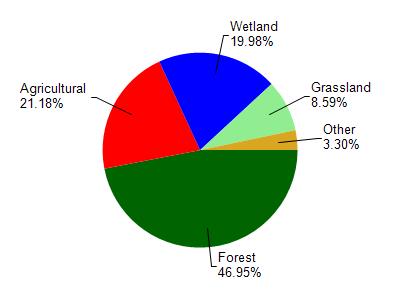Waushara
No
No
No
Fish and Aquatic Life
Overview
, in the White River Watershed, is a 7.76 acre lake that falls in Waushara County. This lake is managed for fishing and swimming and is currently not considered impaired.
Date 2011
Author Aquatic Biologist
Historical Description
A small, drained lake having a spring water source, the lake is infertile and has clear water. The outlet drains east for less than one-half mile before entering the White River northwest of Neshkoro. The lake is very shallow, with nearly 75 percent of its area having less than three feet of water. The littoral bottom material is entirely muck. The game fish species present include northern pike, largemouth bass, bluegills and black crappies. Carp are also present but not in large numbers. Due to the extensive shallow areas, the lake may experience periodic winterkills. The lake is subject to occasional fluctuating water levels because of its proximity to the White River and because of an impounding effect created by a railroad grade during periods of peak runoff. Thirty-one acres of adjoining wetlands enhance wildlife values in the area of the lake. A few puddle ducks (mallards and bluewing teal) nest in the vicinity of this lake each year. There is one cottage on the lake. There is no access other than the navigable access from the White River through the outlet of the lake. Hunting around the lake is allowed with permission. Source: 1970, Surface Water Resources of Waushara County Bannerman Lake T-18-N, R-11-E, Section 32 Surface Acres = 5.2; S.D.F. = 1.56; Maximum Depth = 6 feet
Date 1970
Author Surface Water Inventory Of Wisconsin
Condition
Wisconsin has over 84,000 miles of streams, 15,000 lakes and milllions of acres of wetlands. Assessing the condition of this vast amount of water is challenging. The state's water monitoring program uses a media-based, cross-program approach to analyze water condition. An updated monitoring strategy (2015-2020) is now available. Compliance with Clean Water Act fishable, swimmable standards are located in the Executive Summary of Water Condition in 2018. See also the 'monitoring and projects' tab.
Reports
Management Goals
Wisconsin's Water Quality Standards provide qualitative and quantitative goals for waters that are protective of Fishable, Swimmable conditions [Learn more]. Waters that do not meet water quality standards are considered impaired and restoration actions are planned and carried out until the water is once again fishable and swimmable
Management goals can include creation or implementation of a Total Maximum Daily Load analysis, a Nine Key Element Plan, or other restoration work, education and outreach and more. If specific recommendations exist for this water, they will be displayed below online.
Monitoring
Monitoring the condition of a river, stream, or lake includes gathering physical, chemical, biological, and habitat data. Comprehensive studies often gather all these parameters in great detail, while lighter assessment events will involve sampling physical, chemical and biological data such as macroinvertebrates. Aquatic macroinvertebrates and fish communities integrate watershed or catchment condition, providing great insight into overall ecosystem health. Chemical and habitat parameters tell researchers more about human induced problems including contaminated runoff, point source dischargers, or habitat issues that foster or limit the potential of aquatic communities to thrive in a given area. Wisconsin's Water Monitoring Strategy was recenty updated.
Grants and Management Projects
| Project Name (Click for Details) | Year Started |
|---|
|
|
Monitoring Projects
| WBIC | Official Waterbody Name | Station ID | Station Name | Earliest Fieldwork Date | Latest Fieldwork Date | View Station | View Data |
|---|
| 151300 | Bannerman Lake | 10007422 | Bannerman Lake | 7/27/1999 | 9/22/2017 | Map | Data |
|

Watershed Characteristics
Bannerman Lake is located in the White River watershed which is 149.81 mi². Land use in the watershed is primarily forest (47%), agricultural (21.20%) and a mix of wetland (20%) and other uses (11.90%). This watershed has 156.65 stream miles, 1,017.38 lake acres and 18,495.17 wetland acres.
Nonpoint Source Characteristics
This watershed is ranked Not Ranked for runoff impacts on streams, Not Ranked for runoff impacts on lakes and High for runoff impacts on groundwater and therefore has an overall rank of High. This value can be used in ranking the watershed or individual waterbodies for grant funding under state and county programs.However, all waters are affected by diffuse pollutant sources regardless of initial water quality. Applications for specific runoff projects under state or county grant programs may be pursued. For more information, go to surface water program grants.